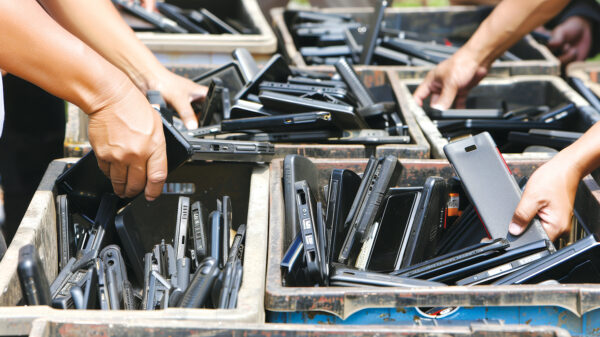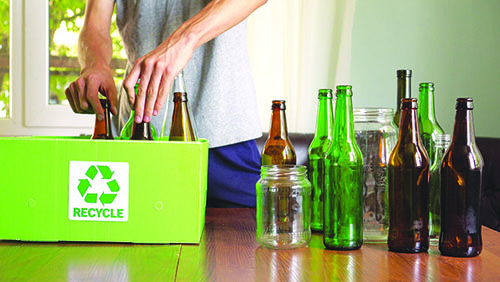by MAURA KELLER
The last couple of years proved to be difficult for copper recyclers and scrap traders dealing with the metals market. But luckily, copper has seen a surge of sorts with increased demand in recent years due to the urbanization and industrial growth of China and India, as well as the worldwide surge in electronics and renewable energy sources.
That said, the Chinese government’s recently imposed tougher copper scrap import requirements may result in a tighter supply of more refined copper scrap.
According to Trevor Bergfeldt, PhD, vice president of operations and strategic development at emew Corporation, a company that provides clean technology solutions for environmental stewardship, metal recovery, energy efficiency and waste water treatment, as more and more copper is mined, the grade of copper deposits continues to decline, which consequently requires processing higher volumes of lower-grade material.
“All of this drives mine development costs up and puts pressure on the economic viability of these projects,” Bergfeldt said. “For these reasons, copper recovery from secondary materials such as scrap, metallurgical residues and other waste materials are becoming more and more important in recent years.”
As Bergfeldt explained, copper prices have always fluctuated, valued at less than $1 per pound in the late 1990s/early 2000s, rising as high as $4 per pound in early 2008 before the crash, and then rebounding to a high of $4.50 per pound in late 2010/early 2011. In the past three years, prices have dipped from $3 to $2 per pound and in recent months have risen back to over $3 per pound.
According to advisory services firm KPMG, 2017 was a strong year for copper, with prices enjoying gains of nearly 25 percent during the year. Early indications are that the market will swing into an undersupply) position in early 2019 but there is the potential for this to occur earlier. This means that copper prices should continue their upward trend in 2018, but this time in a more sustained manner.
“Demand for copper is expected to be quite bullish for the next few years owing in part to electric vehicles and renewable energy sources, which require more copper compared to their conventional counterparts. This makes for strong primary (mining) and secondary (scrap/recycling) copper markets,” Bergfeldt said.
Impact on Recyclers
It’s important to note that the primary and secondary copper markets are not isolated from each other. Bergfeldt stressed that with today’s industries striving for higher productivity, less waste and closed-loop processes, the primary and secondary copper industries will become even more interconnected.
“As primary resource grades decline, the scrap and recycling industries will play more integrated roles in the lifecycle of copper to enhance the overall sustainability of the industry,” Bergfeldt said. “Even today there is overlap between the primary and secondary copper industries with nonferrous fractions from recycling of e-waste being processed at primary metallurgical facilities due to the infrastructure already in place to recover high-purity metals from these complex, mixed-metal feeds.” By embracing new technologies, the recycling/recovery industry will be able to process materials the primary metallurgical facilities cannot in order to close the loop.
In fact, emew’s technology has proven ideal for copper recovery from complex, low-grade, mixed-metal solutions often found in copper recycling, copper refinery bleed, copper SX-EW bleed, and direct electrowinning from copper leach solutions.
The original and patented emew electrowinning technology was developed by emew in Australia in 1992 to overcome some of the limitations of conventional electrowinning. Here’s how it works: In general, electrowinning is a process in which metal ions are recovered from solution when a direct current is applied across an anode and cathode submerged in an electrically conductive solution causing the metal to deposit onto the cathode.
“Conventional electrowinning uses planar anodes and cathodes submerged in a stagnant electrolyte bath which can cause complications with depletion zones, low purity product and low current efficiency under certain common conditions,” stated Bergfeldt.
The emew electrowinning technology uses cylindrical cells in which the electrolyte is rapidly circulated past the electrodes at very high velocities which overcomes the issues associated with depletion zones, and enables depletion of metal to much lower concentrations while achieving the highest purity of metal possible.
As Bergfeldt explained, the emew electrowinning cells are closed systems that completely eliminate acid mist and other noxious gasses making it a much safer place to work.
Chinese Ban Impact
Although historically China has relied on imports for around half of its scrap copper needs, the Chinese government informed the World Trade Organization in 2017 that it would stop accepting certain types of foreign solid waste, including metals, if they did not meet stricter impurity thresholds. In 2017, China’s top three sources of scrap copper included Hong Kong, the U.S. and Australia, accounting for about 45 percent of the imports during the first 11 months of 2017.
Part of its goal to limit imports of what China refers to as “Category 7” scrap metal means that it will have far-reaching implications for the copper market. According to statistics released from China’s General Administration of Customs, there were significant drops in imported scrap metal volumes in January 2018 as compared to the previous year. For example, the shipment of scrap metal to China fell to 490,000 metric tons compared with a volume of 660,000 metric tons in January 2017. The January 2018 amount of aluminum, copper, and ferrous scrap reflects a 30 percent drop from December 2016 and a 5.7 percent drop from one year ago.
“Since the infrastructure of our cities, industries and technologies depend on the red metal, the outlook for copper is bullish,” Bergfeldt said. “Copper recycling and recovery from secondary low-grade materials and complex scrap will become increasingly important in the coming years as primary resource grades decline. The time is ripe for recycling/recovery companies to lead the industry in the use of innovative technologies to economically and sustainably recover copper from a growing list of low-grade, mixed-metal streams.”
Published in the May 2018 Edition







